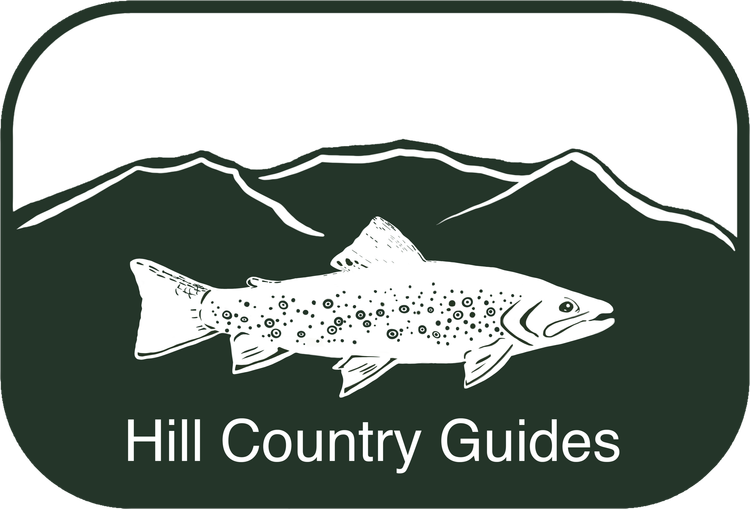As a guide I have seen my share of big fish caught and big fish lost. People often ask me, "Is it harder to hook or land a big fish?" While it takes a lot of knowledge to get a big fish on the line, it is even more of a challenge to get that fish to the net. Here are some tips to help you land the big one.
1. Inspect your gear before and while you are fishing. Big fish are often lost when there is a weak point in your rigging.
A. Wind knots are a common culprit but nicks and frayed line are just as much of a problem. Improving casting technique can minimize these problems (see number 2) but it is always a good practice to inspect your leader and line regularly. Also be sure to match the correct tippet size to the flies and fish you are after. It is not necessary to fish 6X tippet when you are after big fish eating size twelve mayflies. I prefer 4X and even 3X in such situations. With streamers 2X to 0X ensure that an aggressive predatory trout does not break you off on the strike.
B. Gear selection and maintenance is important. I've often heard people say, "You are better off putting more money into your fly rod than your fly reel." This is under the assumption that the reel will not be used to fight a fish that can take line. Once you lose a big fish due to a faulty drag system, you will understand the importance of a good reel. As for fly rods, be sure to use faster action rods when fishing streamers and nymphs as these rods will give you better hook sets. When fishing small dry flies for big trout you will want a slower action rod that has a good flex and will protect lite tippets.
2. Casting technique and line control. When I introduce beginners to the fly cast I try to emphasize the importance of keeping a straight wrist on the back cast. While this is essential to get your forward cast to straighten out, it is just as important in keeping tippets and leaders from getting frayed and weakened. The next piece I introduce to beginners is how to shoot line and retrieve line from under the index finger on their casting hand. This seemingly simple practice is commonly done incorrectly and results in many problems when hooking and landing a big fish. Once the fly lands on the water a fish may strike. If the line does not come under the trigger finger on the casting hand, one cannot set the hook on a striking fish. Once the hook set is complete the angler must then keep the line under their trigger finger and keep tension.
3. Control the fish. The way to control a fish will depend on: the fish's size, strength, and water conditions. If I hook a fish in water with a good deal of debris I am going to be sure to lift that fish out of the structure, conversely if a fish is in open water I am going to keep a low rod angle (down and to the side) to ensure that the fish does not leave the water and shake the hook. If I have fast water below me I am going to keep my rod tip angled upstream to be sure the fish doesn't run into the fast water below. While all of this might sound complicated, it is not unlike trying to keep a kite under control in the wind. You want the fish moving under tension but in your preferred direction.
4. When a fish runs. When a fish runs the angler needs to be prepared to point the rod tip at the fish and let the fish take drag. If you hook a big fish it is a good idea to take up as much line as you can before the fish makes a run. Of course if you hook a very big fish she will take the line before you have time to deal with it. In such cases letting the line slide progressively through your fingers is your best bet. Once you have a fish on the reel the fish can be fought from the reel, especially with larger arbor reels. Of course if a fish decides to charge straight towards you it may be necessary to take line by hand again.
5. If a fish tries to jump. When a fish tries to jump it is important to keep tension on the fish and a low rod angle. This ensures that the hook will stay in the fish's mouth even when airborn.
6. Landing a big fish. When landing a large trout, steelhead or salmon, a large net is a good ally and a good net-man is your best ally. You will want your net-man to be downstream of the fish if possible. When the fish begins to tire work to get the fish broadside, meaning that the width of the fish is turned to the surface. If you can get the fish broadside, a quick thrust with the net is the best bet to subdue your quarry. Often an overly cautious net-man will dip the net slowly, allowing the fish time to notice the net, and run. While smaller fish will simply let you net them, larger fish will not. The fear of snapping the tippet with a brisk thrust of the net needs to be overcome in order to ensure high rates of success.
I hope this quick tutorial gives you at least one thing you can focus on when it comes to landing the big one. Feel free to leave comments on your own experiences with fighting big fish.
